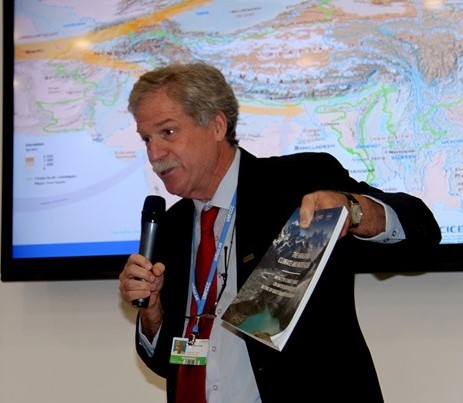Climate and water atlas of Hindu Kush Himalayas launched

TBNews —
Kathmandu/ Paris – Negotiations at COP 21 are heading towards a conclusion. But no matter what the wording of the final text, there is agreement that adaptation to climate change needs to begin now. Nowhere is this more true than in the world’s mountain regions, which have been identified by the Intergovernmental Panel on Climate Change (IPCC) as among the most vulnerable to climate change.
Global water resources are facing increasing pressure from climate change and rising consumption. This problem is especially acute in the Hindu Kush Himalayan mountains, which are home to 210 million people and provide water to over 1.3 billion people – more than the entire continent of Europe. These people live in one of the most populous, disaster-prone and vulnerable regions in the world, yet knowledge about the changing climate in the mountains and possible climate change impacts is still limited and scattered.
To help address this problem, three organisations came together to produce the region’s first climate and water atlas, a guidebook for policy makers who are tackling crucial adaptation issues. The Himalayan Climate and Water Atlas: Impact of Climate Change on Water Resources in Five of Asia’s Major River Basins was released by the International Centre for Integrated Mountain Development (ICIMOD), GRID-Arendal and the Centre for International Climate and Environmental Research-Oslo (CICERO).
The first of its kind, the atlas offers a comprehensive, regional understanding of the changing climate and its impact on water resources in five of the major river basins in the region – the Indus, Brahmaputra, Ganges, Salween and Mekong. It uses maps and infographics to show how the region’s climate is changing now and into the future, with severe consequences for populations, both local and downstream.
David Molden, Director General of ICIMOD, stresses the importance of the new research study.‘This Atlas sheds light on the state and fate of the water resources of the Hindu Kush Himalayas, a region that is highly vulnerable to climate change and one of the poorest regions in the world’, Molden says. ‘The information in the Atlas presents science-based information that will help develop solutions and take the necessary action to deal with changes in the region’.
Drawing on several years of research under the Himalayan Climate Change Adaptation Programme (HICAP), with external reviews from international experts, the atlas contains new findings about the impacts of climate change on the region, including:
Temperatures across the mountainous Hindu Kush Himalayan region will increase by about 1–2°C (in some places by up to 4–5°C) by 2050.
Precipitation will change with the monsoon expected to become longer and more erratic.
Extreme rainfall events are becoming less frequent, but more violent and are likely to increase in intensity.
Glaciers will continue to suffer substantial ice loss, with the main loss in the Indus basin.
Communities living immediately downstream from glaciers are the most vulnerable to glacial changes.
Despite overall greater river flow projected, higher variability in river flows and more water in pre-monsoon months are expected, which will lead to a higher incidence of unexpected floods and droughts, greatly impacting on the livelihood security and agriculture of river-dependent people.
Changes in temperature and precipitation will have serious and far-reaching consequences for climate-dependent sectors, such as agriculture, water resources and health.
The atlas also includes a number of key recommendations for policy makers to encourage the development of flexible and cooperative strategies, including between countries, to deal with increased variability and meet the challenges posed by either too much or too little water.
‘Mountains and their importance as water towers for the world should be higher on the global climate change agenda,’ says Børge Brende, Norway’s Minister of Foreign Affairs. ‘We are confident that the Himalayan Climate and Water Atlas will help raise the visibility of mountains in the global climate change discourse’.
Funded by the governments of Norway and Sweden, the atlas was launched at a COP 21 side event on International Mountain Day, entitled ‘Celebrating international cooperation on climate change adaptation in mountain environments – from Rio to Lima to Paris’. – ICIMOD / Dec. 11, 2015














